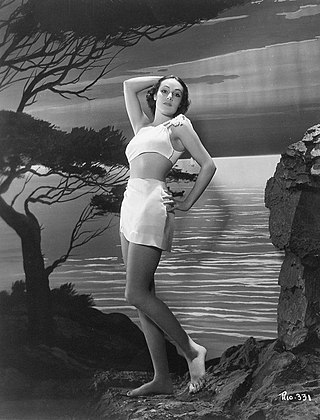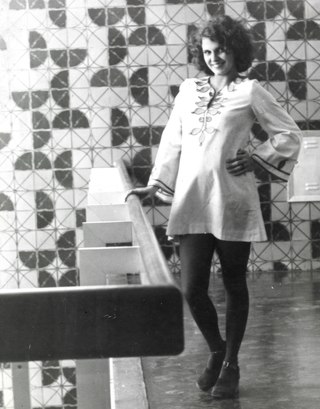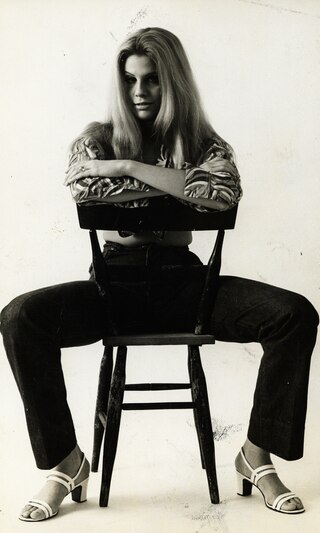Related Research Articles

A bikini is a two-piece swimsuit primarily worn by women that features one piece on top that covers the breasts, and a second piece on the bottom: the front covering the pelvis but usually exposing the navel, and the back generally covering the intergluteal cleft and some or all of the buttocks. The size of the top and bottom can vary, from bikinis that offer full coverage of the breasts, pelvis, and buttocks, to more revealing designs with a thong or G-string bottom that covers only the mons pubis, but exposes the buttocks, and a top that covers only the areolae. Bikini bottoms covering about half the buttocks may be described as "Brazilian-cut".

A swimsuit is an item of clothing designed to be worn by people engaging in a water-based activity or water sports, such as swimming, diving and surfing, or sun-orientated activities, such as sun bathing. Different types may be worn by men, women, and children. A swimsuit can be described by various names, some of which are used only in particular locations or for particular types of suit, including swimwear, bathing suit, bathing attire, swimming costume, bathing costume, swimming suit, swimmers, swimming togs, bathers, cossie, or swimming trunks, besides others.

The monokini was designed by Rudi Gernreich in 1964, consisting of only a brief, close-fitting bottom and two thin straps; it was the first women's topless swimsuit. His revolutionary and controversial design included a bottom that "extended from the midriff to the upper thigh" and was "held up by shoestring laces that make a halter around the neck." Some credit Gernreich's design with initiating, or describe it as a symbol of, the sexual revolution.

"Garota de Ipanema", "The Girl from Ipanema", is a Brazilian bossa nova and jazz song. It was a worldwide hit in the mid-1960s and won a Grammy for Record of the Year in 1965. It was written in 1962, with music by Antônio Carlos Jobim and Portuguese lyrics by Vinícius de Moraes. English lyrics were written later by Norman Gimbel.

Gisele Caroline Bündchen is a Brazilian fashion model. Since 2001, she has been one of the highest-paid models in the world. In 2007, Bündchen was the 16th-richest woman in the entertainment industry and earned the top spot on Forbes top-earning models list in 2012. In 2014, she was listed as the 89th-most-powerful woman in the world by Forbes.

Ipanema is a neighbourhood located in the South Zone of the city of Rio de Janeiro, Brazil, between Leblon and Arpoador. The beach at Ipanema became known internationally with the popularity of the bossa nova song, "The Girl from Ipanema", written by Antônio Carlos Jobim and Vinícius de Moraes.

Glória Maria Cláudia Pires de Morais is a Brazilian actress. She is best known for her roles in TV Globo telenovelas such as Dancin' Days, Vale Tudo, Mulheres de Areia and O Rei do Gado. She is also known for starring in films such as Academy Award-nominated O Quatrilho, box-office hit If I Were You and its sequel, and Lula, Son of Brazil, which is the second most expensive Brazilian film of all time, after Nosso Lar.
Roberta Gambine Moreira is a Brazilian fashion model, actress and television personality. She is constantly mentioned in the media as one of the greatest Brazilian icons and one of the main sex symbols in the country between the 1980s and 1990s, in addition to being a pioneer of transfeminism in her native country.

Fernanda Cama Pereira Lima is a Brazilian television presenter and model. In spite of a short career in film and telenovelas, she has established herself in popular culture, as a host to a variety of shows on MTV Brasil, Rede TV!, and TV Globo. In 2014, she has been contracted by FIFA to be the muse of the World Cup and of the Ballon d'Or.

Astrud Gilberto was a Brazilian samba and bossa nova singer and songwriter. She gained international attention in the mid-1960s following her recording of the song "The Girl from Ipanema".

Many stylistic variations of the bikini have been created. A regular bikini is a two-piece swimsuit that together covers the wearer's crotch, buttocks, and breasts. Some bikini designs cover larger portions of the wearer's body while other designs provide minimal coverage. Topless variants are still sometimes considered bikinis, although they are technically not a two-piece swimsuit.

The thong is a garment generally used as either underwear or in some countries, as a swimsuit. It may also be worn for traditional ceremonies or competitions.

Leila Roque Diniz was a Brazilian television, film and stage actress, whose liberal ideas and attitudes about sex had raised the discontent of both the feminists and the Brazilian military government of the 1960s.

Andressa de Faveri Urach is a Brazilian reality television personality, best known for being a contestant on the sixth season of A Fazenda, the Brazilian version of The Farm.

"Girl from Rio" is a song by Brazilian singer Anitta from her fifth studio album Versions of Me. It was released as the second single from the album through Warner Records on April 29, 2021. A song about Anitta's own life, it interpolates "The Girl from Ipanema" by Vinicius de Moraes and Tom Jobim. A remix of the song featuring American rapper DaBaby was released on May 21, 2021, and was sent to US and European radio stations on May 25.

Rosiane de Souza Pinheiro is a Brazilian dancer, model, actress, media personality and a sex symbol. She rose to prominence as a dancer for the music band Gang do Sambaand in the 1990s and has gone on to appear in numerous magazine photo shoots, including on the cover for the Brazilian Playboy in June 1998. Rosiane has also acted in numerous television series, TV commercials and in few films.

Sandra Bréa Brito was a Brazilian actress and model. An exponent of the Porn Art Movement, she was one of Brazil's main sex symbols, especially in the 1970s, having posed nude several times for magazines such as Playboy and Status among the others. Sandra was a key figure in the sexploitation film genre known as Pornochanchada in Brazil in the 1970s. She was also known for publicly admitting that she was infected with the HIV virus in August 1993. She died of lung cancer in 2000.
Adele Fátima is a Brazilian actress, model and dancer. She was one of Brazil's main sex symbols, especially in the 1970s and was a key figure in the sexploitation film genre known as Pornochanchada in Brazil in the 1970s.

Angelina Maria Muniz Zagari, is a Brazilian actress and former model. She is one of the popular Brazilian sex symbols of the late 1970s and early 1980s after she appeared nude in some Brazilian films. Angelina had also posed nude three times for the men's magazine Playboy.
Tereza Nicole Puzzi Ferreira is a Brazilian actress, model and television presenter. One of the popular Brazilian sex symbols of the late 1970s and early 1980s, she is considered as a key figure of the Pornochanchada film genre of Brazil.
References
- ↑ Garcia, Roosevelt (17 March 2017). "Por onde andam estas sex-symbols dos anos 70, 80 e 90? | Memória" [Where are these sex-symbols from the 70s, 80s and 90s?]. Veja São Paulo (in Brazilian Portuguese). Archived from the original on 30 July 2023. Retrieved 4 October 2023.
- ↑ "Rose Di Primo, simbolo da mulher brasileira e musa de Ipanema" [Rose Di Primo: The Symbol of Brazilian Women and The Muse of Ipanema]. Pier de Ipanema (in Brazilian Portuguese). 8 June 2020. Archived from the original on 7 December 2021. Retrieved 4 October 2023.
- ↑ "Brazilian beach fashion: An analysis of vogue magazine and discovered body" (PDF). University of Brazilia. 2017. Archived (PDF) from the original on 8 September 2023. Retrieved 4 October 2023.
- ↑ "Antonia Morais se inspirou em musa e criadora da tanga na década de 70 para post" [For this Post, Antonia Morais was Inspired by the 70s Muse and Creator of the Thong]. Extra Online (in Brazilian Portuguese). 30 January 2019. Archived from the original on 26 January 2021. Retrieved 4 October 2023.
- ↑ "Rose di Primo, a inventora da tanga" [Rose di Primo, the Inventor of the Thong]. Tio Oda (in Brazilian Portuguese). 10 September 2015. Archived from the original on 4 October 2023.